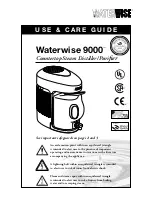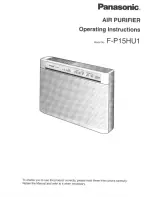
OPERATING INSTRUCTIONS
TIPS ON HOW TO USE YOUR STEAM CLEANER
Fiberglass or Stainless Steel Surfaces
Use the bristle brush. Slowly move the
brush over the surface to be cleaned.
The vapor will emulsify the dirt and
grease on the surface. Follow behind
with a terry cloth towel over the brush to
remove excess moisture and residue.
Tip
: An old idea for polishing stainless
steel is to wipe it down with seltzer soda
water after it is cleaned.
Bathroom Areas
To clean the bathtub or shower area, use
the bristle brush for grout, shower door
tracks, hard to get areas and heavily
soiled areas. The dual edge window/tile
squeegee will be the most efficient way
to clean the rest of the area. Allow plenty
of time for the heat to penetrate the
surface. This is especially helpful in the
shower area if there is tile or grout. Wipe
with towel.
Removal of soap scum on tile, grout, and
shower doors is also easier with the
steam cleaner.
To clean sanitary fixtures, use the
concentrator with or without bristle brush.
Use a terry cloth towel or paper towel to
wipe up excess moisture and residue.
To clean the sink and faucets, use bristle
brush then finish by wiping with a towel.
Soap Scum
Soap scum dissolves almost immediately
under a combination of heat and
moisture. Rinse the surface with a small
amount of water afterwards or go back
over it once more with a clean terry cloth
towel.
Note:
Soap scum sometimes will develop
a hard surface from waterborne minerals.
If this is the case, use the bristle brush to
break up this surface - or spray or wipe
first with lemon, vinegar or seltzer soda
water to soften the minerals.
Moving too slowly can dry out the soap
scum and cause it to granulate on the
surface. The surface will have a gritty
feel. If this happens, apply vapor to the
surface with the bristle brush again and
re-clean.
Garden Furniture
Use any of the brushes depending on the
surface area. Work quickly when
cleaning resin outdoor furniture. Finish
by wiping with a towel.
Steam Trigger
Lock
Using the Trigger Lock
The steam cleaner has a steam trigger
lock. The steam trigger will lock when
you slide the lock upwards.
(Fig. 6) To unlock the steam trigger, just
slide it downwards. If you want to have
continuous steam, squeeze the steam
trigger and then slide
the steam trigger
lock towards
trigger.
WARNING
:
This appliance is
under pressure. After every use,
unplug the unit and squeeze the
steam trigger button until all
pressure has been released
before removing safety cap.
Allow unit to cool for fifteen (15)
minutes before refilling.
Fig. 6
Fig. 9
Locking Button
Hand Grip
Fig. 8
6
Fig. 7
Refilling Your Steam Cleaner
WARNING:
Only refill the unit
when boiler is empty and steam
output has ceased. Allow unit to
cool for 15 minutes before
refilling
.
Extreme care should be
taken when refilling the unit. Use
caution when opening the Safety
Cap as it may become hot during
use and escaping steam can
cause scalding.
Step 1: Squeeze the steam trigger on the
hand grip to vent any residual
steam that is in the boiler. This
ensures that the boiler is out of
water.
Step 2: Unplug the unit and allow to cool
for fifteen (15) minutes. Continue
to fill according to “Operating and
Filling Your Steam Cleaner”
instructions.
IMPORTANT:
It is not recommended to
refill your unit if there is still steam coming
out when the steam trigger is pressed.
Preparing Your Steam Cleaner for
Storage After Use
When cleaning tasks are complete it is
recommended that you follow these steps
to keep your steam cleaner in good
working order.
Step 1: Unplug unit and allow to cool for at
least 40 min.
Step 2: After unit has been allowed to cool,
slowly loosen safety filler cap to
remove.
Step 3: To empty the boiler tank, tip the
steam cleaner over a sink, to empty
of all water then replace cap
loosely onto unit.
WARNING:
If unit is still hot, there
is a risk that water will squirt back
during filling and cause scalding.
Blinds
Use the nylon bristle brush to clean
blinds. Move the brush over the
surface, allowing enough time for the
vapor to penetrate. Work quickly on
PVC blinds. Test for color fastness on
fabric blinds before using. Finish by
wiping with a towel.
Automotive
For detailing the wheels, use the
concentrator and the bristle brush.
Exterior windows are cleaned best by
applying the vapor with the concentrator
and following with a paper towel.
To clean bicycles, use the bristle brush.
To clean equipment, use the bristle
brush, depending on the surface area.
Finish by wiping down with a towel.
Artificial Plants
Use the concentrator without a brush
attached to blow off the dust and dirt.
Clothing
A vapor cleaning system is excellent for
removing wrinkles from fabrics. Simply
“vaporize” the surface from a distance
(12”-18”) The dry vapor removes
wrinkles without leaving the fabric wet
like ordinary fabric steamers do.
Nicotine and Tar
Nicotine and tar dissolves at high
temperatures and becomes a light
yellow oil that has the consistency of
sewing machine oil. When the
nicotine/tar film is touched by steam
pocket, it immediately dissolves and
flows into the steam pocket towel. You
can remove it from flat surfaces as fast
as you can move the steam pocket over
the surface.
Removing Wax, Tar, Etc.
Many stains are only stuck on the
surface of materials and can be easily
and quickly removed by “blowing”
excess material away from the surface
from the side. This is accomplished by
using the concentrator. Hold the terry
cloth towel to the side to catch the loose
residue as it is blown by the
concentrator.
NOTE
: Always vacuum any loose
residue off the surface before you apply
vapor to it.
Using the Variable Steam Feature
Your steam cleaner has a variable steam
feature that allows you to adjust the
steam flow to the job that you are doing.
The variable steam control is located on
the handgrip. To increase the steam
flow, turn the knob counter clockwise and
to decrease, turn it clockwise. (Fig. 7)
Using Your Steam Cleaner with
Steam Pocket
Step 1: Connect one of the extension
tubes to the hand grip on the
flexible steam hose. To attach
the extension tubes one onto
the other or onto the hand grip,
press the locking button
ensuring that it fits into the hole.
(Fig. 8, Fig. 9) To disconnect,
repeat the operation by
pressing the locking button and
pulling the two sections apart.
11




























